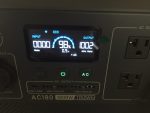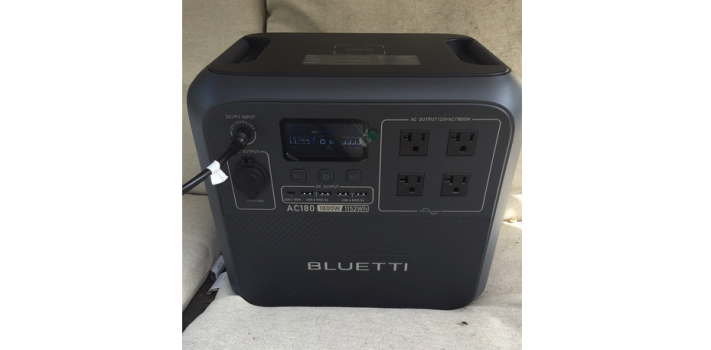(Continued from Part 1. This concludes the article.)
THE BLUETTI 180P
This brings us to a real-world solution: the Bluetti AC180. This is a charge controller/battery bank/inverter in a single, elegant package. The heart of the AC180 is a bank of Lithium Iron batteries with an advertised life of 3,500 charge/discharge cycles and is warranted for five years. Integrated into the package is a charge controller capable of charging from a number of sources: 120 VAC house supply, car charger, or solar panels. It then is capable of supplying that stored power in a number of ways: various USB connections, a 12 volt DC cigarette lighter plug, a cordless charging capability, and four 120 VAC receptacles. The inverter necessary to convert the direct current stored in the batteries to the alternating current at the 120 VAC receptacles is integrated into the package as well.
 One of the most useful features I have found is the control panel: it displays a number of important parameters including charging power in, discharge power out, and remaining percent of stored charge. The AC180 has a maximum output current of 15 amps at 120 VAC for a total maximum power discharge of 1800 watts (AC180: get it?) and a power over time from a full charge of 1152 watt hours. There are a number of useful programmable features built in; however, I am using the default settings that came with the device.
One of the most useful features I have found is the control panel: it displays a number of important parameters including charging power in, discharge power out, and remaining percent of stored charge. The AC180 has a maximum output current of 15 amps at 120 VAC for a total maximum power discharge of 1800 watts (AC180: get it?) and a power over time from a full charge of 1152 watt hours. There are a number of useful programmable features built in; however, I am using the default settings that came with the device.
With this information in hand, combined with the power requirements of the Instant Pot we can calculate whether the AC180 will be capable of providing the necessary power. Will the AC180 deliver at least 8 amps at 120 VAC? Yep: easily. Will it supply 228-watt hours of power? Indeed. Five times from one charge. The AC180 should work to supply an Instant Pot. We shall see.
It is noteworthy that the AC180 is highly portable. It weighs a very manageable 35 pounds and includes two integrated carry handles. Whether moving to different locations to maximize utility or throwing it into the car to bug out, it is easy to transport.
TESTING THE AC180
The AC180 arrived with a charge of 62%. I plugged a small fan in and let it run: I noted that the fan was drawing 50 watts and was able to observe over the space of the next 12 hours as the fan drew the AC180 charge nearly down to 0. To save power the display is not illuminated continuously; pressing the power button momentarily turns on the display for approximately 30 seconds. The AC180 continued to operate the fan without difficulty throughout the entire test.
 I then plugged the AC180 into a 120 VAC receptacle: it took a little over an hour to fully recharge the batteries. Next, I plugged the Instant Pot into the AC180P and hard boiled a dozen eggs. I was able to observe the power discharge of approximately 1000 watts during the warm up stage and then occasional activation of the Instant Pot heater throughout the cooking phase. Consistent with the full power discharge capacity of 1,152 watt-hours the entire process used 20% of the AC180 capacity.
I then plugged the AC180 into a 120 VAC receptacle: it took a little over an hour to fully recharge the batteries. Next, I plugged the Instant Pot into the AC180P and hard boiled a dozen eggs. I was able to observe the power discharge of approximately 1000 watts during the warm up stage and then occasional activation of the Instant Pot heater throughout the cooking phase. Consistent with the full power discharge capacity of 1,152 watt-hours the entire process used 20% of the AC180 capacity.
THE PV200 SOLAR PANEL ARRAY
 Along with the AC180 Portable Power Station I purchased one PV200 solar panel array. This consists of 4 panels mounted and wired to maximize portability: unfold the panels, locate and orient to maximize the sunlight, turn on the AC180, and plug the included cables to the appropriate port on the AC180 to begin charging using solar energy.
Along with the AC180 Portable Power Station I purchased one PV200 solar panel array. This consists of 4 panels mounted and wired to maximize portability: unfold the panels, locate and orient to maximize the sunlight, turn on the AC180, and plug the included cables to the appropriate port on the AC180 to begin charging using solar energy.
While the PV200 is rated at 200 watts output, this is under optimum conditions. Another benefit of the AC180 control panel is the ability to see the charging power. When I performed the charging test there was alternating clouds and sun: when receiving full sun I noted a maximum charging power from the PV200 of approximately 150 watts; this decreased to approximately 70 watts when a cloud passed by. In three hours of midday clouds/sun (mostly sun) the PV200 restored 14% of the charge to the AC180.
It is worth noting a very useful feature of the AC180 which is “pass-through” capability: this simply means that you can be both charging and discharging simultaneously. If the charging input is greater than the discharge output the difference will be used to charge the batteries; conversely the batteries will be tapped to supplement the charging input if the discharge is greater.
While I would say the AC180 is excellent in design and execution, my assessment of the PV200 is much more qualified. If your goal is portability and simplicity the PV200 is right for you: it folds and secures in a 16-pound package with a convenient carry handle. It includes some propping stands that are, frankly, laughable: I cannot imagine anyone actually using them to prop and direct the panels. However, it is easy to lean the unfolded panels against something to position. It is a simple matter to plug the PV200 into the AC180 with the provided cables.
CONCLUSION
The total cost of the AC180 and SV200 package was just under $1,300 with sales tax and free shipping. Given the capabilities of the components (especially the AC180) I am very pleased with the purchase. The Bluetti website has a very useful comparison chart that shows the power requirements of a number of typical devices: once you have a sense of what you want to power you can consult this chart and determine the appropriate Bluetti components.
Recalling the solar charging example above it is noteworthy that a single PV200 solar panel array is not likely to be able to fully recharge the AC180, even on a sunny summer day and certainly not on a cloudy day. There is provision for this in the AC180: it is capable of handling up to 500 watts of solar charging power but there is a very large caveat at accompanies this capability: the voltage from the solar panels cannot exceed 60 VDC and the current cannot exceed 10 amps.
Why does this matter? Two PV200 solar panel arrays may be used with the AC180: the PV200 has a maximum output voltage of 26.1 volts and a maximum output current of 9.7 amps. The PV200 arrays have MC4 connectors which allow you to connect the two panel arrays in series: the positive (red) wire of the first PV200 goes to the positive (red) wire of the connecting cable to the AC180. The negative (black) wire of the first PV200 goes to the positive (red) wire of the second PV200. The negative (black) wire of the second PV200 goes to the negative (black) wire of the connecting cable to the AC180.
The result is that the combined output of the two PV200 arrays now has a maximum output voltage of 52.2 volts (twice the output of each array) and a maximum output current of 9.7 amps: both of these parameters stay within the limits of the AC180 (60 volts DC and 10 amps: almost like they planned it that way!) and you now have 400 watts of solar charging capability rather than the 200 watts available from a single PV200.
Bluetti makes it clear that the AC180 does not require Bluetti solar panels. Any solar panels that fall within the electrical requirements of the AC180 and utilize the appropriate connector are compatible. However, the alternate solar panels must still fall within the limits of the AC180 (60 VDC, 10 amps). Do you want to use Harbor Freight 100 watt Thunderbolt panels? Note that the panels have a published output voltage of 18 VDC but I have seen YouTube videos where the actual output with full sun is more than 20 volts: if you connect three panels in series to get 300 watts of solar energy you may exceed the 60 VDC limit of the AC180.
I may well wish to construct a solar panel array that produces 400 watts of solar power using panels that are more durable than the PV200; however, careful study is required to ensure I stay within the capabilities of the AC180.
By the way, Bluetti discourages trying to mix different kinds of panels as this can lead to problems, as well.
THE BOTTOM LINE
Is a solar power generator system feasible for you? That is difficult to answer. What is your climate? I live in Western Pennsylvania which rivals Seattle for cloudy, rainy days, particularly from November through March. If I had to operate at least a small refrigerator (for example, to store insulin) I would require a larger, more costly system. Will I be able to maintain all functions presently powered from the grid? Certainly not.
However, there is a very great deal that can be accomplished with a system such as the AC180 with 200-400 watts of solar panel capacity, even in a less-than-ideal location such as mine. The Instant Pot is one such example (and probably worthy of an article of its own by someone more adept at using it than me.) This presents a way to cook food that does not require liquid fuel or a flame which could be useful for a number of reasons.
Lighting technology with the advent and development of LED lamps is a game changer for efficient, flameless lighting. Small fans can greatly increase our comfort in the absence of air conditioning, battery-powered tools may be easily recharged and even corded power tools may be used to greatly increase work efficiency. Even relatively low-power electronics such as laptop computers will be available for work and entertainment and rechargeable batteries such as Eneloop AA/AAA can enable numerous small electronic devices.
A solar power system that enables me to power all of the same devices presently supplied with grid power is not feasible. A solar power system that greatly improves my life in the event of temporary or even permanent failure of the power grid is entirely feasible: I have one.
Note that I have received no inducement from Bluetti (as you might guess by the very frank assessment of the PV200): I purchased the AC180/PV200 and this has been my experience thusfar.










